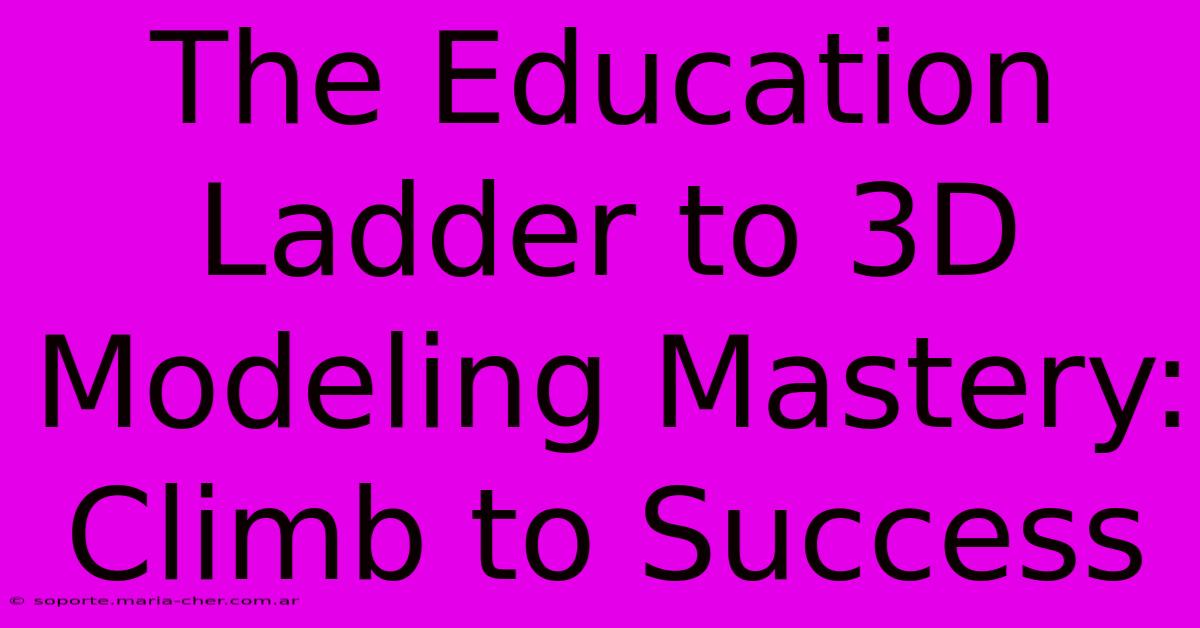The Education Ladder To 3D Modeling Mastery: Climb To Success

Table of Contents
The Education Ladder to 3D Modeling Mastery: Climb to Success
The world of 3D modeling is vast and exciting, offering lucrative career opportunities and creative freedom. But mastering this skill requires dedication and a strategic approach to education. This article serves as your guide, outlining the educational steps you can take to climb the ladder to 3D modeling mastery and achieve your career goals.
Choosing Your First Rung: Foundational Knowledge
Before diving into complex software, a strong foundation is crucial. This initial phase focuses on acquiring core knowledge and understanding fundamental concepts:
1. Understanding 3D Principles:
- Geometry and Spatial Reasoning: A solid grasp of geometry—shapes, volumes, and spatial relationships—is paramount. Familiarize yourself with terms like polygons, vertices, edges, and normals. Practice visualizing objects in three dimensions.
- Perspective and Composition: Learn the basics of perspective drawing and composition. Understanding how to create depth and visual interest is key to crafting compelling 3D models.
- Digital Art Fundamentals (Optional but Beneficial): While not strictly necessary, basic knowledge of digital painting and sculpting techniques can enhance your modeling skills and allow for more creative texturing.
2. Choosing Your Software:
Several powerful 3D modeling software packages exist, each with its strengths and weaknesses. Popular choices include:
- Blender: Free and open-source, Blender boasts a comprehensive feature set and a large, supportive community. Ideal for beginners due to its accessibility and vast online resources.
- Autodesk Maya: An industry-standard software used extensively in film, animation, and game development. Powerful but requires a steeper learning curve and a subscription fee.
- 3ds Max: Another industry-standard software, 3ds Max is renowned for its polygon modeling capabilities and integration with other Autodesk products. Also requires a subscription.
- Cinema 4D: Known for its intuitive interface and powerful rendering capabilities, Cinema 4D is a popular choice for both beginners and professionals.
Ascending the Ladder: Intermediate Skills and Specialization
Once you've grasped the fundamentals, it's time to hone your skills and explore specialization:
1. Mastering Your Chosen Software:
- Focus on Tutorials and Practice: Dedicate time to comprehensive tutorials, focusing on specific aspects of your chosen software, like modeling techniques, UV mapping, and texturing. Consistent practice is key.
- Personal Projects: Work on personal projects that challenge your skills and allow you to experiment with different techniques. This is where you'll truly develop your creative abilities.
- Online Courses and Workshops: Consider enrolling in online courses or workshops to deepen your understanding and learn advanced techniques from experienced professionals.
2. Exploring Specialization:
- Hard Surface Modeling: Focus on creating hard-surface models like vehicles, machinery, and buildings. Requires precision and attention to detail.
- Organic Modeling: Specialize in creating organic models like characters, creatures, and plants. Requires a strong understanding of anatomy and topology.
- Environmental Modeling: Create realistic and immersive 3D environments for games or architectural visualizations. Involves building complex scenes and utilizing various assets.
- Character Modeling: A highly specialized area, character modeling demands expertise in anatomy, expression, and rigging.
Reaching the Peak: Advanced Techniques and Professional Development
The top of the ladder involves mastering advanced techniques and developing a professional portfolio:
1. Advanced Techniques:
- Topology and Retopology: Learn efficient topology for animation and rigging. Retopology helps to create clean and optimized models.
- UV Mapping and Texturing: Develop expertise in creating seamless UV maps and applying realistic textures using various techniques.
- Rigging and Animation (Optional): If you're interested in animation, learn the art of rigging and animating your 3D models.
- Rendering and Lighting: Master advanced rendering techniques and lighting setups to create photorealistic or stylized images.
2. Building Your Portfolio:
- Showcase Your Best Work: Create a portfolio website showcasing your best 3D models and projects. Highlight your skills and specialization.
- Networking: Attend industry events, join online communities, and network with other 3D modelers and professionals.
The Climb Never Ends: Continuous Learning
The field of 3D modeling is constantly evolving. Continuous learning is essential to staying relevant and improving your skills. Stay updated on the latest software updates, techniques, and industry trends. Embrace challenges, experiment, and never stop learning. With dedication and a strategic approach to education, you can successfully climb the ladder to 3D modeling mastery.

Thank you for visiting our website wich cover about The Education Ladder To 3D Modeling Mastery: Climb To Success. We hope the information provided has been useful to you. Feel free to contact us if you have any questions or need further assistance. See you next time and dont miss to bookmark.
Featured Posts
-
Gridiron Giants Uncover The Most Dominant College Football Names That Strike Fear
Feb 06, 2025
-
Celtics Trade Springer Pick To Rockets
Feb 06, 2025
-
The Devilish Charm Of D And D Ferrari Red A Hue That Embodies Evil And Temptation
Feb 06, 2025
-
Unlock The Secrets Of Long Lasting Gel Polish Dnds Revolutionary Formula
Feb 06, 2025
-
Discover The Secrets Of Flawless Jpeg To Png Conversion A Game Changer For Your Content
Feb 06, 2025
